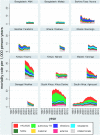Diverse Empirical Evidence on Epidemiological Transition in Low- and Middle-Income Countries: Population-Based Findings from INDEPTH Network Data
- PMID: 27187781
- PMCID: PMC4871496
- DOI: 10.1371/journal.pone.0155753
Diverse Empirical Evidence on Epidemiological Transition in Low- and Middle-Income Countries: Population-Based Findings from INDEPTH Network Data
Abstract
Background: Low- and middle-income countries are often described as being at intermediate stages of epidemiological transition, but there is little population-based data with reliable cause of death assignment to examine the situation in more detail. Non-communicable diseases are widely seen as a coming threat to population health, alongside receding burdens of infection. The INDEPTH Network has collected empirical population data in a number of health and demographic surveillance sites in low- and middle-income countries which permit more detailed examination of mortality trends over time.
Objective: To examine cause-specific mortality trends across all ages at INDEPTH Network sites in Africa and Asia during the period 1992-2012. Emphasis is given to the 15-64 year age group, which is the main focus of concern around the impact of the HIV pandemic and emerging non-communicable disease threats.
Methods: INDEPTH Network public domain data from 12 sites that each reported at least five years of cause-specific mortality data were used. Causes of death were attributed using standardised WHO verbal autopsy methods, and mortality rates were standardised for comparison using the INDEPTH standard population. Annual changes in mortality rates were calculated for each site.
Results: A total of 96,255 deaths were observed during 9,487,418 person years at the 12 sites. Verbal autopsies were completed for 86,039 deaths (89.4%). There were substantial variations in mortality rates between sites and over time. HIV-related mortality played a major part at sites in eastern and southern Africa. Deaths in the age group 15-64 years accounted for 43% of overall mortality. Trends in mortality were generally downwards, in some cases quite rapidly so. The Bangladeshi sites reflected populations at later stages of transition than in Africa, and were largely free of the effects of HIV/AIDS.
Conclusions: To some extent the patterns of epidemiological transition observed followed theoretical expectations, despite the impact of the HIV pandemic having a major effect in some locations. Trends towards lower overall mortality, driven by decreasing infections, were the general pattern. Low- and middle-income country populations appear to be in an era of rapid transition.
Conflict of interest statement
Figures





References
-
- Omran AR. The epidemiologic transition. A theory of the epidemiology of population change. The Milbank Memorial Fund quarterly. 1971;49(4):509–38. - PubMed
Publication types
MeSH terms
LinkOut - more resources
Full Text Sources
Other Literature Sources

